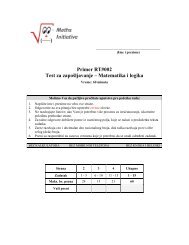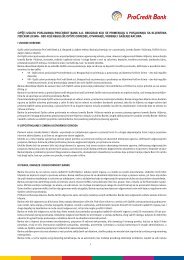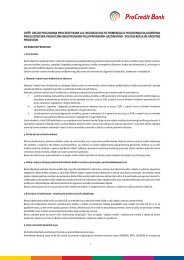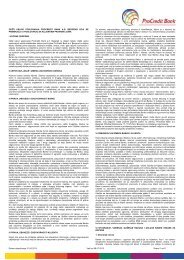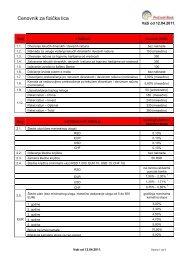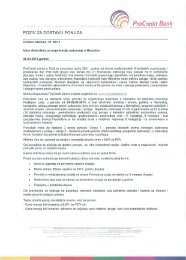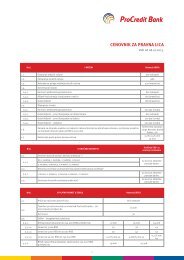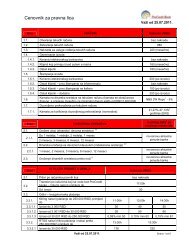Annual Report 2010 - ProCredit Bank
Annual Report 2010 - ProCredit Bank
Annual Report 2010 - ProCredit Bank
- No tags were found...
Create successful ePaper yourself
Turn your PDF publications into a flip-book with our unique Google optimized e-Paper software.
60<br />
<strong>Annual</strong> <strong>Report</strong> <strong>2010</strong><br />
in the given risk class (calculated provisions), as well as the sum of<br />
individual impairments for clients with provisions at the individual<br />
level. In case of provisions at the portfolio level, risk weight defined<br />
by this document for each risk class is applied.<br />
With respect to off-balance sheet items the <strong>Bank</strong> does not have provisions<br />
for liabilities, pursuant to internal methodology, but solely<br />
equity provisions on the basis of criteria defined by the National<br />
<strong>Bank</strong> of Serbia.<br />
On the occasion of loan approval, the loan will according to PCB<br />
classification be classified in class I (loan is not in arrears on the<br />
occasion of approval). Credit rules and Credit risk management<br />
policy allow lending exclusively to clients with good business results<br />
who satisfy strict eligibility criteria defined by the <strong>Bank</strong> and<br />
its shareholders, ensuring thus ex-ante rigid and prudent credit<br />
risk assessment for all clients.<br />
All balance sheet items, which should according to the general<br />
rules change the risk class in respect of the number of days in arrears,<br />
will not be reclassified if the amount in arrears is less than<br />
EUR 2.00 (31 December <strong>2010</strong>:1 EUR = 105.4982 RSD).<br />
Group /individual provisioning<br />
With regards to group provisioning, provisions are calculated by<br />
applying general weight for internal risk class for the respective client<br />
and related parties with the respect of contamination principle<br />
for the outstanding amount, while in case of individual provisions<br />
the individual provisioning amount is specified for the client who<br />
meets the prescribed criteria.<br />
Group provisioning<br />
On a group basis loans are classified in specific internal risk classes<br />
for the party, according to the number of days in arrears, and the provisions<br />
are formed by applying general weight for a certain risk class<br />
of the party onto the basis, which is defined hereinafter. General<br />
weight is defined by internal methodology based on the migration<br />
analysis which represents historical development of the portfolio on<br />
the basis of which weights that present likelihood for a certain party<br />
to be in the status of liability non-settlement are defined in compliance<br />
with the internal policy. General provisioning weight in the<br />
preceding period and the equivalent of the <strong>Bank</strong>’s average historical<br />
losses is the weight in use for a large number of parties, namely it is<br />
defined as average volume at the portfolio level.<br />
Rules for calculation of the provisioning basis<br />
Provisions for losses are pursuant to the internal policy allocated<br />
for loans, credit cards and authorized current account overdrafts,<br />
bill of exchange protests, private individual account fees, account<br />
transaction fees, i.e. for balance sheet assets of the bank exposed<br />
to credit risk.<br />
The provisioning basis includes:<br />
• Principal amount undue<br />
• Due principal and interest, booked penalty interest<br />
• Authorized current account overdraft – used portion of the approved<br />
limit (receivables on the balance sheet), as well as unauthorized<br />
overdraft amount<br />
• Credit cards – used portion of the approved limit (receivables on<br />
the balance sheet), as well as unauthorized overdraft amount<br />
• Receivables on the balance sheet originating from off-balance<br />
sheet assets, bill of exchange protests and paid letters of credit<br />
• Account transaction fees, and private individual account fees<br />
Receivables as the basis for calculation of provisions against loan<br />
losses are reduced by the deposit amount.<br />
Rules for classification<br />
Classification of the party/client relies on the following principles:<br />
• The principle of the number of days in arrears per client’s party<br />
• Contamination principle, i.e. the party/client and all parties of<br />
related persons are monitored, and then all parties are given the<br />
lowest risk class a party has. If the client can be found in more<br />
than one group of related parties, the client will have the lowest<br />
class a party in any one of the groups of related parties has, but<br />
will not transfer this class to the party which is not in the group in<br />
which the party on the basis of which the relevant party has been<br />
allocated a lower class is located (e.g. A related to B, and A related<br />
to C, A will therefore define the class B, but B will not define the<br />
class C in cases when A has the worst class among all 3 clients).<br />
• The portfolio of reprogrammed loans has a classification that<br />
differs from the rest of the portfolio. The breakdown of reprogrammed<br />
loans includes following categories: Standard,<br />
Watch and Impaired, depending on the criteria defined by a<br />
special document Rules for reprogrammed credit exposure. A<br />
reprogrammed loan from the category Watch (a loan in arrears<br />
over 30 days at the moment of reprogramming) will have a different<br />
risk class compared to the class defined as standard for<br />
the rest of the portfolio. Classification of the reprogrammed<br />
portfolio is a part of the document Procedure for internal classification<br />
and provisioning.<br />
• Credit cards and fees for transaction accounts and private individual<br />
accounts will not exert impact on reclassification of other<br />
clients’ parties from the viewpoint of the rule for related parties<br />
if the card/overdraft/fee claim is less than or equal to EUR<br />
1,000 (31 December <strong>2010</strong>: 1 EUR = 105.4982 RSD), because<br />
of their material insignificance as regards the total portfolio.<br />
These parties will have their class established according to the<br />
number of days in arrears on the classification date. Therefore,<br />
if there is a legal entity borrower in the <strong>Bank</strong>, and the owner as<br />
related party is using a credit card in the amount of up to EUR<br />
1,000, credit card default will not have impact on reclassification<br />
of credit parties disbursed to the legal entity.<br />
Provisioning weights:<br />
General/group classification Party class Provisioning Provisioning<br />
weight <strong>2010</strong> weight 2009<br />
No repayment arrears or arrears up to 30 days I 1.00% 1.00%<br />
Reprogrammed loan – Standard, arrears up to 30 days Standard 3.50%<br />
Reprogrammed loan – Watch, arrears up to 30 days Watch 12.00% 7.00%<br />
Reprogrammed impaired – arrears up to 30 days Impaired 25% 25%<br />
Arrears between 31 and 90 days II 55% 45%<br />
Arrears between 91 and 180 days III 70% 60%<br />
Arrears between 181 and 360 days and terminated agreements IV 100% 100%<br />
Individual provisioning Impairment Individually Individually<br />
determined determined



